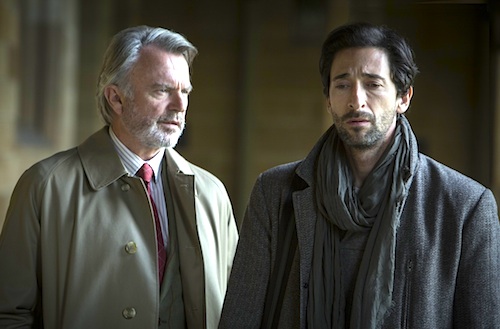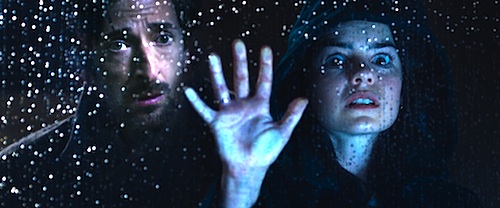
By Joe Bendel. There are two things that always worked in Hitchcock movies: trains and psychiatrists. It is therefore a rather shrewd strategy for screenwriter Michael Petroni to combine them in his feature directorial debut. Sometimes it makes sense, sometimes it doesn’t, but it is always stylish when head-shrinker Peter Bower tries to get his head around his traumatic past in Petroni’s Backtrack, which was recently acquired by Saban Films after successfully screening at the 2015 Tribeca Film Festival.
Still devastated by the accidental death of their pre-teen daughter, Bower and his wife Carol have moved back to Melbourne, hoping the change of scenery will do them good. For the time being, Bower’s practice consists of evaluation-cases referred by his former teacher, Dr. Duncan Steward. These patients seem to have a lot of issues, but they can hardly compare to the visibly disturbed teenager Elizabeth Valentine. She has all kinds of problems, starting with the fact her records say she died in 1987.
Evidently, one Elizabeth Valentine was a victim of a tragic train derailment accident that devastated Bowers’ provincial hometown of False Creek years ago. While Bowers investigates the circumstances surrounding the catastrophe, he starts to remember his own unfortunate involvement. As he stirs up a hornet’s nest of local resentment, the pushback of the living and the torments of the ghosts start to jog Bowers’ long suppressed memories.
Frankly, there are a lot of logical holes in Backtrack, but they are mostly concentrated in the first half hour. If you are willing to gloss over them, the film picks up considerable steam in the second and third acts. Throughout it all, Petroni demonstrates a mastery of atmosphere, building suspense through creepy ambiance and the restrained use of Grudge-like supernatural effects.

It is hard to imagine Adrien Brody saying “put another shrimp on the Barbie,” but his sad-eyed, hang-dog screen persona works quite well for Bowers. As usual, Sam Neill’s forceful bearing classes up the joint, even if his character, Dr. Steward, really doesn’t make a lot of sense. George Shevtsov also adds some grizzled seasoning as Bowers’ old man. However, Bruce Spence (whose mind-blowing credits include the Mad Max, Star Wars, Matrix, and Narnia franchises) arguably lands the best scene as Bowers’ jazz musician patient.
Part of the fun of Backtrack is identifying where the pieces fit seamlessly into each other and where they are just sort of jammed together. Cinematographer Stefan Duscio (who lensed the breathtaking Canopy) gives it all the perfect look of noir foreboding. Petroni rewards viewers who can overlook the narrative’s early ragged edges with a lot of clever bits down the stretch. Recommended for psychological thriller fans not inclined towards pedantry, Backtrack will eventually hit theaters following its successful world premiere at this year’s Tribeca Film Festival.
LFM GRADE: B
Posted on April 27th, 2015 at 1:20pm.